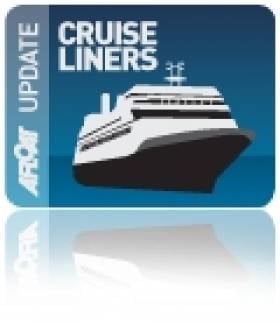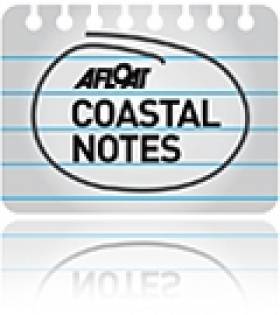Displaying items by tag: coastline
Irish & Welsh Coastlines Explored in New TG4 Series
The courtship rituals of bottle-nosed dolphins, basking sharks congregating off the Irish coast and the sex-shifting cuckoo wrasse are documented in a new wildlife series on the Celtic coasts.
“Iontas na bhFarraigí Ceilteachta” is a three-part series presented by Eoin Warner which will be broadcast on TG4 from January 12th.
The series filmed over two years in ultra high definition by some of the filmmakers behind natural history series Blue Planet, according to TG4.
The team took “a corner of these islands which has never previously been explored in such sumptuous detail – Ireland’s sunny southeast and the Welsh coast”, it says.
Footage of blue sharks, basking sharks and fin whales is included, along with guillemots – the seabirds that can “fly” underwater - and the blenny fish which can breathe on land.
“Getting close to nature – especially given recent lockdown events- provides such a great escape for the soul,” director Paddy Hayes said.
 Eoin Warner goes kayaking in Iontas na bhFarraigí Ceilteachta
Eoin Warner goes kayaking in Iontas na bhFarraigí Ceilteachta
“ The Iontais na bhFarraigí Ceilteacha team captured some really breath-taking footage of our undiscovered coasts and some eye-opening behaviour of our best-known marine animals’ – and it is such a joy to know that all this occurs just off our shores,” he said.
The three episodes of Iontais na bhFarraigí Ceilteacha are divided into three habitats - the shores, the shallows and the deep.
Warner explores the marine animals that inhabit the coastlines of Ireland and Wales who need to adapt to this rapidly changing environment in the first part, on the shores, and he goes kayaking off Waterford’s copper coast.
In part two, Warner goes skindiving in the shallow seas where he explores “the seabed bursting with life”, including filming a female catshark as she lays an egg or “mermaid's purse’” deep in the kelp forest floor.
Lady's Island Lake in County Wexford, where Arctic terns have arrived to breed, is also captured in this episode. Arctic terns spend the summer fishing in these shallow waters to feed their young, and then embark on the longest migration of any living thing on Earth.
The final episode, on the deep, explores animals from the giant fin whale to the tiny microplankton that is responsible for 50% of the air that we humans breathe.
“In this episode, we encounter a bait ball – many different species co-operating in a deep-water feeding frenzy,” the team says.
“ We first encounter a group of fin whales - at twenty-five meters long, these majestic submarine-shaped creatures are the planet’s second-largest animals. Joining them to hunt sardines are two-meter-long blue-finned tuna,” they explain, and common dolphins enter the “feeding fray”.
“ Fast-moving, super-intelligent marine mammals, they drive the hapless fish together and push them towards the surface, where they are easily picked off by diving gannets. Spectacular footage shot from above and below the water captures the freneticism of this extraordinary wildlife phenomenon,” they state.
Iontais Na bhFarraigí Ceilteacha is an Irish/Welsh BBC/TG4 co-production by Tua Films & One Tribe TV.
Graham Norton's 'Jaw-Dropping' Alaska Coastline Experience
#CRUISE LINERS - TV host and funnyman Graham Norton recounts his breathtaking experiences on a cruise to Alaska for the Mail on Sunday.
"Until Alaska, my own serious nautical experience was crossing the Irish Sea on a car ferry," writes the Cork native best known for his BBC chat show.
But the remoteness of the Alaskan coastline - as seen from the decks of the Crystal Symphony - struck him with a special kind of awe.
"Enjoying Alaska's natural wonders It's hard not to be amazed as you cruise into wilderness areas such as Glacier Bay because they're so jaw-droppingly spectacular. It's absolutely beautiful," he says.
"The highlights were the glaciers and the whale-watching. The ship sails right up to the wall of the glacier and you sit there watching large blocks of ice breaking off calving, I think it's called, and it's just stunning."
Norton was especially surprised by his excitement at seeing the whales.
"They're brilliant. Watching them popping out of the sea was really, really, really good! So good, in fact, you kind of think I mustn't go whale-watching again because I'll only be disappointed next time. It was quite an emotional experience. You feel privileged to see these creatures."
Perhaps next time he takes a break in West Cork he might take a look out to sea and witness some of those magnificent creatures a lot closer to home!
Shooter Nears the Finish Line in Solo Kayak Challenge
Elaine 'Shooter' Alexander is set for hero’s welcome this week as she becomes the first woman from Northern Ireland to circumnavigate the island of Ireland by kayak.
The solo paddler is expected to reach the finish line at County Antrim Yacht Club on Wednesday after her 70-plus-day test of endurance.
Shooter began her epic 1,000-mile voyage on 3 May, facing a tough challenge navigating a coastline of cliffs and headlands, strong tides and brutal weather. She has been storm-bound for a total of 21 days, often only with a small tent for shelter.
When asked what home comfort she was most looking forward to, she simply replied: "A proper toilet and some clean clothes."
Shooter embarked on the challenge to raise funds for SHARE, a charity providing outdoor activity programmes that promote the inclusion of disabled and non-disabled people.
“I expected and had trained for the physical challenge but I don’t think you can ever prepare mentally," she commented.
"It has been a real struggle coping with the repetition of paddling, getting changed into wet clothes and packing up a wet tent every day. Especially on the windy days it has been hard just to push on that extra few miles each day.”
But connecting with fans and supporters through social media made a big difference.
“The Facebook page has really been a lifeline," she said. "There is nothing more motivating than coming off the water after a tough day to read so many supportive and funny comments from well wishers."
See below for a map showing Shooter's live position as she edges closer to the finish line.
Survey of Irish Coast Begins Next Weekend
Members of the public are being urged to volunteer for the first survey since 2005. It starts in Ireland next weekend.
More from the Irish Times HERE.


























































